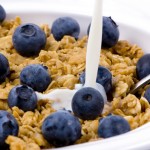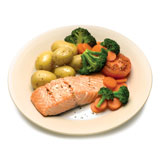 So far, my Nutrition Challenges have included:
So far, my Nutrition Challenges have included:
- Eating at least 7 servings of fruits & vegetables each day
- Drinking at least 64 fluid ounces of water each day
- Eating at least every 3-4 hours (multiple small meals/ large snacks)
On the surface these seem simple enough, but it may be more challenging to keep building healthy nutrition habits than anticipated. One reason for this is simply that starting new habits means changing old habits. And changing old habits takes a conscious effort and forethought. It takes time to form new habits (30 days is the standard suggestion). So initially, the desired behavior must be planned and intentional; which takes some effort. Don’t be discouraged though because if you are able to stick with it for a few weeks it will begin to become a habit and will be more of an “autopilot” behavior. That’s what we’re after!
There is a basic strategy that will help set you up for success. While this could easily be a independent Nutrition Challenge, I am going to insert it here as a support tool to help you be successful at meeting all the Nutrition Challenges. The strategy I’m referring to is PLANNING AHEAD. While I am not, by nature, a highly organized individual (ask those who know me), I do know that if I want to reach any type of goal I need to have a plan. Without a plan I am likely to wander aimlessly or get frustrated because I have “on days” and “off days”. So as each of the Nutrition Challenges is introduced, think about how you can plan ahead to make reaching your goal more likely to happen.
 Setting a specific plan for eating more fruits and vegetables may be as easy as purposing to eat fruit at least twice a day and vegetables at least twice a day. (Many pieces of fresh fruit are worth 2 “servings, and it’s easy to eat more than one vegetable portion at a meal.) My next step then is to determine when in my day I am going to put these servings. For example, I can start every day with a serving or 2 of fresh fruit, and then make a habit of having a second piece at lunch, after my workout, or as part of one of my snacks. Likewise, I can plan to have at least 1 serving of veggies in my lunch and at least 2 in my dinner. Now I have a plan of where in my day I will be including these, and I am more likely to be successful.
Setting a specific plan for eating more fruits and vegetables may be as easy as purposing to eat fruit at least twice a day and vegetables at least twice a day. (Many pieces of fresh fruit are worth 2 “servings, and it’s easy to eat more than one vegetable portion at a meal.) My next step then is to determine when in my day I am going to put these servings. For example, I can start every day with a serving or 2 of fresh fruit, and then make a habit of having a second piece at lunch, after my workout, or as part of one of my snacks. Likewise, I can plan to have at least 1 serving of veggies in my lunch and at least 2 in my dinner. Now I have a plan of where in my day I will be including these, and I am more likely to be successful.
Likewise, developing a strategy to help me remember to drink more water each day will help me to achieve that goal. My plan can include having a glass of water before leaving home in the morning. I may also purpose to keep a bottle or cup of water at my desk while I’m working and set intermediate goals of drinking a certain amount before a morning meeting, before lunch, etc. I may make it a point to take a cup of water with me to meetings when I’m likely to finish it off out of boredom or fidgetiness. Perhaps my strategy will include keeping a water bottle within reach when watching TV or working on the computer at home. You get the idea, so develop or adapt some strategies that will help you reach your hydration goal.
 Eating frequently definitely takes some forethought. It means you will need to think through your day and determine when the most reasonable times to eat will be. Where are you at recommended meal or snack times? What kind of snack is appropriate or realistic for the time and setting? What will make it easier for me to eat at that time. If I plan on having an apple for a snack at work, would I be more likely to finish it if it were sliced? If I am in a meeting most mornings, perhaps a non-fat latte would be a realistic snack at that time of day. Can I stop and eat a yogurt in the afternoon, or is something like an energy bar a more practical choice for me? Also consider the habits of your co-workers. If they make a latte run every afternoon, do you want to make a habit of getting a small non-fat latte as your snack? Would you rather have a drip coffee and supply your own healthy snack? Is it best to avoid this temptation all together (because you will probably get a mocha AND a pastry)? If you’ve had your snack BEFORE the latte run, perhaps you will be less likely to succumb because you’re not so hungry. Lots to consider. So think ahead, consider where you will be, what is available, convenient and reasonable, and if bringing your own snacks with you or purchasing them is best.
Eating frequently definitely takes some forethought. It means you will need to think through your day and determine when the most reasonable times to eat will be. Where are you at recommended meal or snack times? What kind of snack is appropriate or realistic for the time and setting? What will make it easier for me to eat at that time. If I plan on having an apple for a snack at work, would I be more likely to finish it if it were sliced? If I am in a meeting most mornings, perhaps a non-fat latte would be a realistic snack at that time of day. Can I stop and eat a yogurt in the afternoon, or is something like an energy bar a more practical choice for me? Also consider the habits of your co-workers. If they make a latte run every afternoon, do you want to make a habit of getting a small non-fat latte as your snack? Would you rather have a drip coffee and supply your own healthy snack? Is it best to avoid this temptation all together (because you will probably get a mocha AND a pastry)? If you’ve had your snack BEFORE the latte run, perhaps you will be less likely to succumb because you’re not so hungry. Lots to consider. So think ahead, consider where you will be, what is available, convenient and reasonable, and if bringing your own snacks with you or purchasing them is best. 
I’ll get more into meal planning later, but will plant the seed now that it is a big part of setting yourself up for success. For most of us this means coming up with 2-3 healthy breakfast options and 2-5 healthy lunch options that work for us; and then planning ahead for dinner. I generally suggest taking one day each week to plan your meals for the week. This can mean planning 7 different dinners each week, or it can mean planning 3-4 dinners and planning on eating leftovers the other nights. Once you have your meals & snacks planned for the week, shop accordingly so you have the necessary ingredients on hand. It doesn’t have to be complicated. In fact you will probably find that having a plan in place makes your week go smoother and takes some stress off because you are not constantly trying to figure out what to have for dinner each night. You know before you get home…in fact, you know before you leave home in the morning (and have what you need to make it on hand). Your success rate for healthy delicious eating just went up! (click here for more helpful tips from experts)
 So take a little time on the front end to think things through and put together a simple plan for the day, the week, etc…and watch how much easier it is to conquer the Nutrition Challenges!
So take a little time on the front end to think things through and put together a simple plan for the day, the week, etc…and watch how much easier it is to conquer the Nutrition Challenges!

